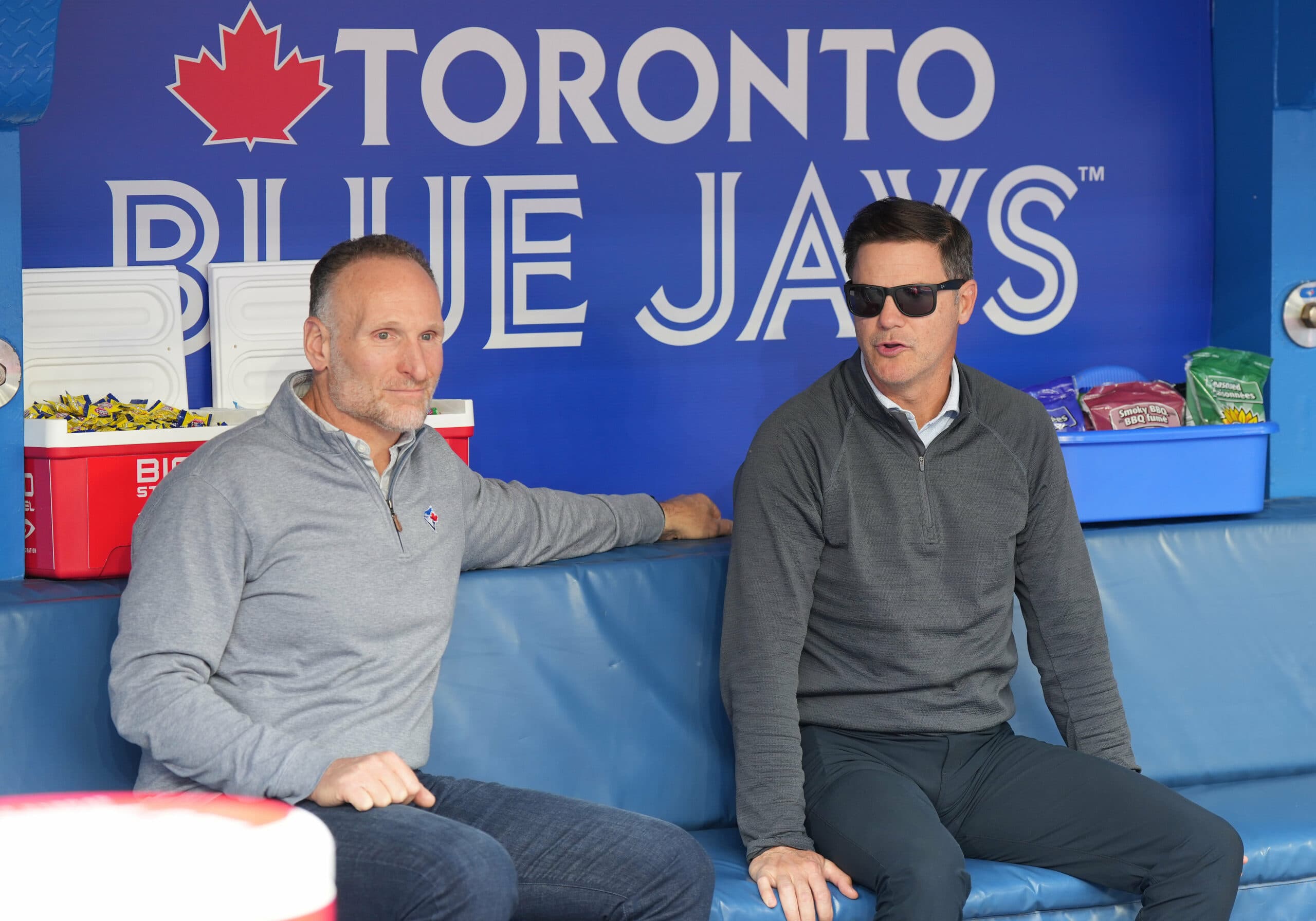Blue Jays’ 2024 payroll structure should allow for opportune spending this winter

Photo credit: © Nick Turchiaro-USA TODAY Sports
By Thomas Hall
Oct 24, 2023, 16:43 EDTUpdated: Oct 26, 2023, 10:41 EDT
There is no reason why the Toronto Blue Jays shouldn’t be among this off-season’s most active teams, just as they were almost 12 months ago – both in free agency and trade discussions.
This club finds itself in a fairly decent position as this winter approaches. Most of their pitching staff – one of the most dominant units in baseball from this past season – should remain intact for 2024. And, despite desperately needing additional power, the position player group is in good hands with superstars Bo Bichette and Vladimir Guerrero Jr. at the centre for at least two more years.
But, of course, there will be several holes to fill over the next few months, especially with five notable players (Matt Chapman, Kevin Kiermaier, Brandon Belt, Jordan Hicks, Hyun Jin Ryu) set to enter free agency – six if you include the Blue Jays declining Whit Merrifield’s $18-million mutual option.
That is a much deeper list than the organization’s 2022 free agents – a thin group headlined by Ross Stripling. As such, Toronto’s front office will have plenty of salary coming off its books, which didn’t occur last winter and necessitated trading Teoscar Hernández and Lourdes Gurriel Jr. to clear space for further additions.
Any moves they make this time, whether it’s via free agency or trade, will require spending money. The good news is, however, that management should possess similar spending capabilities for a second consecutive off-season.
The Blue Jays exceeded MLB’s luxury tax in 2023 ($233 million) for the first time in franchise history, placing them among the eight of 30 clubs to cross that threshold. They finished the season with a luxury tax payroll (or Competitive Balance Tax payroll, as it’s also called) of roughly $248 million – the sixth-highest in baseball, per FanGraphs.
Since they’re a first-time offender, they’ll only be charged a 20 per cent tax on their $15 million overage, resulting in an estimated $2.25 million charge. But that’s a relatively small price to pay, especially considering the cost of remaining a luxury tax team.
If the organization spends beyond the $237 million luxury tax in 2024, it’ll be subject to a 30 per cent penalty – a 10% increase for exceeding the initial threshold in consecutive seasons. At the moment, that tax hike isn’t expected to impact their payroll limitations this winter.
“I don’t expect a dramatic philosophical shift in payroll. I expect us to stay in the same area,” president and CEO Mark Shapiro said of Toronto’s off-season financial flexibility during his end-of-season press conference earlier this month.

Credit: Nick Turchiaro-USA TODAY Sports
So, to better understand the Blue Jays’ financial breathing room, let’s break down the club’s 2024 payroll step by step, starting with their guaranteed contracts.
As currently constructed, Toronto has just under $115 million committed to seven players next season: George Springer, Kevin Gausman, Chris Bassitt, José Berríos, Yusei Kikuchi, Yimi García and Bichette. That figure will likely increase even further once Chad Green’s complex 2024 options are decided.
Individual salaries are not calculated for luxury tax purposes, though. Instead, the average annual value (AAV) of each player’s contract factors into the equation, which, for the Blue Jays, comes out to roughly $115.9 million. Once you add the $61.4 million for the 13 arbitration cases, estimated by MLB Trade Rumors’ model, plus the $8.14 million for pre-arbitration cases, their 2024 commitments draw to a projected $186 million.
If that figure stands, it’d be tied with the Texas Rangers for the fifth-highest in the majors, behind only the Philadelphia Phillies ($203 million), Houston Astros ($205 million), New York Yankees ($241 million) and Mets ($249 million).
After accounting for minor-league 40-man roster salaries, player benefits and their share in the league’s $50-million pre-arbitration bonus pool, the Blue Jays’ 2024 luxury tax payroll – or CBT payroll – lands at an estimated $204.6 million. But that’ll increase by $500,000 with Merrifield’s buyout.
That would position the franchise roughly $31.9 million below next season’s first luxury tax threshold. Based on Shapiro’s recent comments and the glaring holes on the roster, it’s probably safe to assume management will be allowed to, at the very least, spend to that mark. And there may be a few ways to create additional tax space around the margins.
Among the most obvious would be non-tendering reliever Adam Cimber – a free agent after 2024 and a likely DFA candidate next spring – saving Toronto an estimated $3.2 million. Next up could be infielder Santiago Espinal, who underperformed on both sides of the ball this past season and is due a projected $2.5 million as a second-year ARB player.
With Davis Schneider’s emergence, Cavan Biggio’s resurgence and the need for an external veteran middle infielder, as well as the impending arrivals of top prospects Addison Barger and Orelvis Martinez, the Blue Jays can likely afford to cut bait with Espinal this winter. If they do, paired with Cimber’s departure, they could save around $5.7 million and use it to address other pressing needs.
Combining those savings with their current tax space, the front office’s spending range could span between $40-$50 million this off-season, taking them over the luxury tax a second straight winter. Despite a disappointing outcome in 2023, perhaps those limits could extend beyond the second threshold of $257 million.
Doing so would feature an additional 12 per cent surcharge for any overages beyond that mark. But since they’d already be on the hook for a 30 per cent tax for the initial $20 million, why not spend a little bit more at a percentage penalty less than half of the first one, right?
As long as Toronto avoids the $277 million threshold – which comes with the previous two tax penalties, an additional 42.5 per cent surcharge and having a team’s top draft pick pushed back 10 spots – the franchise would steer clear of the more egregious infractions.
Whether or not Rogers Communications, which owns the Blue Jays, would grant Shapiro and his staff the green light for that kind of freedom remains unclear. One thing that is, though, is there should be ample financial space for this team to fill its vacancies while also improving as a whole.
Springer, Gausman and Berríos are the only salaries on the books after the 2025 season. That could easily change if management inks Guerrero, Bichette, or both to long-term deals in the coming months. Or even someone like Danny Jansen – a free agent after next season. But for now, the club’s payroll for 2026 and beyond is wide open.
Given that flexibility, Toronto could toss its hat in the Cody Bellinger sweepstakes this winter, although signing the 2019 NL MVP would undoubtedly hinder their short-term resources. And, based on his prior injury history and prolonged struggles, it’d also be tricky to predict how his lucrative contract would age over time.
On the other hand, amidst a thin free-agent market outside of Bellinger and Shohei Ohtani, the Blue Jays may pursue multiple top-end platoon hitters – like Joc Pederson, Jorge Soler ($9 million player option) or Jeimer Candelario – rather than a single everyday player.
The list of potential options won’t be endless, at least in free agency, but there should be numerous routes to improve an offence that needs to pack more punch next season. That can also be applied to a pitching staff which will have to fill holes in the rotation and bullpen should Ryu and Hicks sign elsewhere.
A few of the five or six roster spots available could be addressed internally. The others will likely have to be procured outside the organization, placing the onus on Toronto’s front office to assemble the correct parts to avoid another post-season disappointment in 2024.
ARTICLE PRESENTED BY BETANO

Breaking News
- Guardians trade former Blue Jay Justin Bruihl to Cardinals
- Report: Yankees presented Cody Bellinger a second contract offer
- Don Mattingly officially joins the Phillies coaching staff
- Blue Jays 2026 40-man Roster Review: Dylan Cease’s potential is sky-high
- 4 teams the Blue Jays do not want to see sign Bo Bichette
